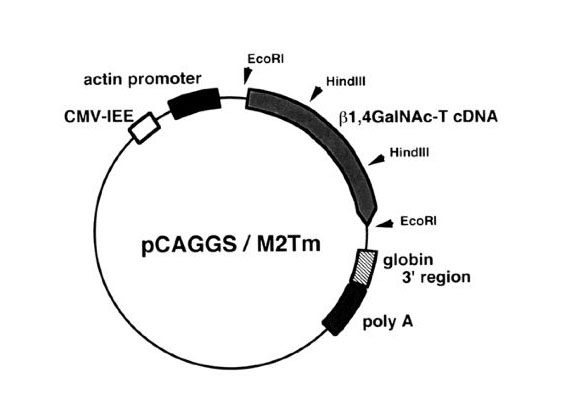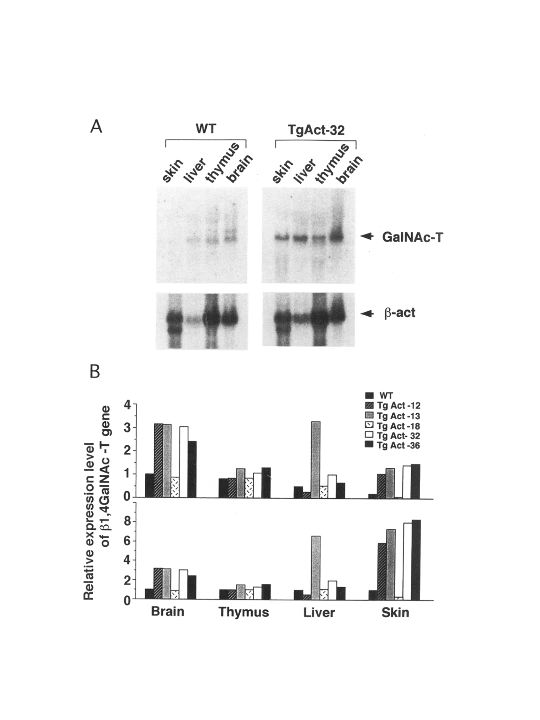General view on engineered mice of glycosyltransferase genes and modifying enzyme genes, and typical examples from our own laboratories were introduced. Todate, a number of glycosyltransferase genes have been isolated and genetic engineering of some of them has been achieved (Furukawa K. et al. 2001; Lowe JB and Marth JD 2003). Depending on the structures and expression patterns of individual genes, detailed constructions and approaches for resulting phenotypes are various. Just standard protocols are presented here as previously reported (Furukawa K. et al. 2006).
Transgenic technique is well-established methodology to generate mouse lines with exogenous gene expression. Tissue specificity of the promoter is critical. |
| Category | Glycogene transgenic animals |
| Protocol Name | Mouse (gene-engineered mice) ~Transgenic mice |
Authors
 |
Furukawa, Koichi
*
Department of Biochemistry II, Nagoya University Graduate School of Medicine
Ohmi, Yuhsuke
Department of Biochemistry II, Graduate School of Medicine, Nagoya University
*To whom correspondence should be addressed.
|
| KeyWords |
|
Reagents
 |
| ● |
cDNA clones which will be used as a transgene |
| ● |
An expression vector with an appropriate promoter to drive the expression of a inserted cDNA |
| ● |
Enzymes and competent cells (Takara Bio Inc., Otsu, Japan) |
|
Instruments
 |
| ● |
Microinjector and microscope (Olympus, Tokyo, Japan) |
| ● |
Current apparatus for maintenance of experimental animals |
| ● |
Current apparatus and instruments to test behavioral abnormalities of mutant mice |
|
| Methods |
|
1. |
Mouse (gene-engineered mice) ~Transgenic mice |
| 1) |
To construct a transgene (Fig. 1), cDNA of mouse β1, 4GalNAc-T (Takamiya K. et al. 1995) in pCDM8 is cleaved with Xho I, and the fragment containing the coding region is inserted into an EcoRI site of the plasmid pCAGGS (Niwa H. et al. 1991). |
Comment 0
|

|
| 2) |
The enzyme function of the transgene, pCAGGS/M2Tm is confirmed by the transfection into a mouse melanoma B16. |
Comment 0
|

|
| 3) |
The injection of the transgene into fertilized eggs was performed by the standard techniques, and Fo mice are obtained. |
Comment 0
|

|
| 4) |
F0 mice are mated each other, and tail DNAs of F1 mice are served for PCR screening to detect the β1,4GalNAc-T transgene. PCR amplification is performed with 0.1 μg of genomic DNA. PCR buffer (50 mM KCl/Tris, pH8.3/2.5 mM MgCl2/0.01% gelatin), 0.1 μg each of primer (antisense primer sequence:440-457 in pTm3-5: 5’-AGAGCACTGATGTTGTACTC-3’/sense primer sequence:923-942: 5’-TTGACGCTGAGGAGCTGA-3’). 1 mM dNTP, and 0.6 unit TaqDNA polymerase (Wako Pure Chemical Industries Ltd., Osaka, Japan). |
Comment 0
|

|
| 5) |
Amplification is carried out by thermal cycler (Astec Co., Ltd., Fukuoka, Japan) for 3 min at 94°C and 30 cycles as follows: 1 min 94°C, 1 min 55°C, and 2 min 72°C. |
Comment 0
|

|
| 6) |
Analyses of the transgene expression by Northern blotting and/or RT-PCR. An example of Northern blotting is shown in Fig. 2. |
Comment 0
|

|
| 7) |
Direct detection of the protein products is also useful when antibodies are available. |
Comment 0
|

|
| 8) |
Analyses of phenotypic changes in Tg mice are essentially same as described in the next chapter for gene knockout mice. |
Comment 0
|
|
|
| Discussion | If the transcripts from the transgene contain following properties, we can distinguish the transcripts from the transgene from that of the endogenous gene.
1. Different mRNA size
2. Different additional sequences in the transcripts
3. Tag-fused products for detection with tag-specific antibodies |
| Figure & Legends |
Figure & Legends β


Fig. 1. Construction of a transgene
Insert cDNA of mouse β1,4GalNAc-T in pCDM8 is cleaved with Xho I, and the fragment containing the coding region is inserted in a EcoRI site of the plasmid pCAGGS.
This figure was originally published in Glycobiology. 7(8):1111-20. 1997 "Genetic remodeling of gangliosides resulted in the enhanced reactions to the foreign substances in skin" Fukumoto S, Furukawa K. et al. Oxford University Press.


Fig. 2. Northern blotting of β1,4-GalNAc-T transgenic mice
mRNA expression levels of the gene were compared with those in the wild type mice.
This figure was originally published in Glycobiology. 7(8):1111-20. 1997 "Genetic remodeling of gangliosides resulted in the enhanced reactions to the foreign substances in skin" Fukumoto S, Furukawa K. et al. Oxford University Press. |
| Copyrights |
 Attribution-Non-Commercial Share Alike Attribution-Non-Commercial Share Alike
This work is released underCreative Commons licenses
|
| Date of registration:2014-02-26 17:52:42 |
- Furukawa, K., Okuda, T., and Furukawa, K. (2006) Roles of glycolipids in the development and maintenance of nervous tissues. Methods Enzymol. 417, 37-52. [PMID : 17132496]
- Furukawa, K., Takamiya, K., Okada, M., Inoue, M., Fukumoto, S., and Furukawa, K. (2001). Novel functions of complex carbohydrates elucidated by the mutant mice of glycosyl- transferase genes. Biochim. Biophys. Acta 1525, 1-12. [PMID : 11342247]
- Lowe, J.B., and Marth, J.D. (2003) A genetic approach to Mammalian glycan function. Annu. Rev. Biochem. 72, 643-691. [PMID : 12676797]
- Fukumoto, S., Yamamoto, A., Hasegawa, T., Abe, K., Takamiya, K., Okada, M., Min, Z.J., Furukawa, K., Miyazaki, H., Tsuji, Y., Goto, G., Suzuki, M., Shiku, H., and Furukawa, K. (1997) Genetic remodeling of gangliosides resulted in the enhanced reactions to the foreign substances in skin. Glycobiology 7, 1111-20. [PMID : 9455912]
- Takamiya, K., Yamamoto, A., Yamashiro, S., Furukawa, K., Haraguchi, M., Okada, M., Ikeda, T., Shiku, H., and Furukawa, K. (1995) T cell receptor-mediated stimulation of mouse thymocytes induces up-regulation of the GM2/GD2 synthase gene. FEBS Lett. 358, 79-83. [PMID : 7821435]
- Niwa, H., Yamamura, K., and Miyazaki, J. (1991) Efficient selection for high-expression transfectants with a novel eukaryotic vector. Gene 15, 108, 193-9. [PMID : 1660837]
|
This work is licensed under Creative Commons Attribution-Non-Commercial Share Alike. Please include the following citation
How to Cite this Work in an article:
Furukawa, Koichi,
Ohmi, Yuhsuke,
(2014). GlycoPOD https://jcggdb.jp/GlycoPOD.
Web.26,4,2024 .
How to Cite this Work in Website:
Furukawa, Koichi,
Ohmi, Yuhsuke,
(2014).
Mouse (gene-engineered mice) ~Transgenic mice.
Retrieved 26,4,2024 ,
from https://jcggdb.jp/GlycoPOD/protocolShow.action?nodeId=t38.
html source
Furukawa, Koichi,
Ohmi, Yuhsuke,
(2014).
<b>Mouse (gene-engineered mice) ~Transgenic mice</b>.
Retrieved 4 26,2024 ,
from <a href="https://jcggdb.jp/GlycoPOD/protocolShow.action?nodeId=t38" target="_blank">https://jcggdb.jp/GlycoPOD/protocolShow.action?nodeId=t38</a>.
Including references that appeared in the References tab in your work is
much appreciated.
For those who wish to reuse the figures/tables, please contact JCGGDB
management office (jcggdb-ml@aist.go.jp).
|
|